Why Are Mikhail Vrubel Paintings Still Discussed Worldwide
Mikhail Vrubel’s art employs a sensitive palette of colours and symbols, and as the artist lays down the wide strokes of the palette knife on the canvas– the painting seems to come to completion. There is a sense of passionate despair one feels after looking at Vrubel’s canvases; the melancholic but subtly vibrant colour schemes he picks only aggravate the sense of despondency. Painting from mostly the 1880s till his death in 1910, this Russian artist anticipated the loss of individuality and faith, predicting the overwhelming despair that was going to dominate Europe in the 20th century.
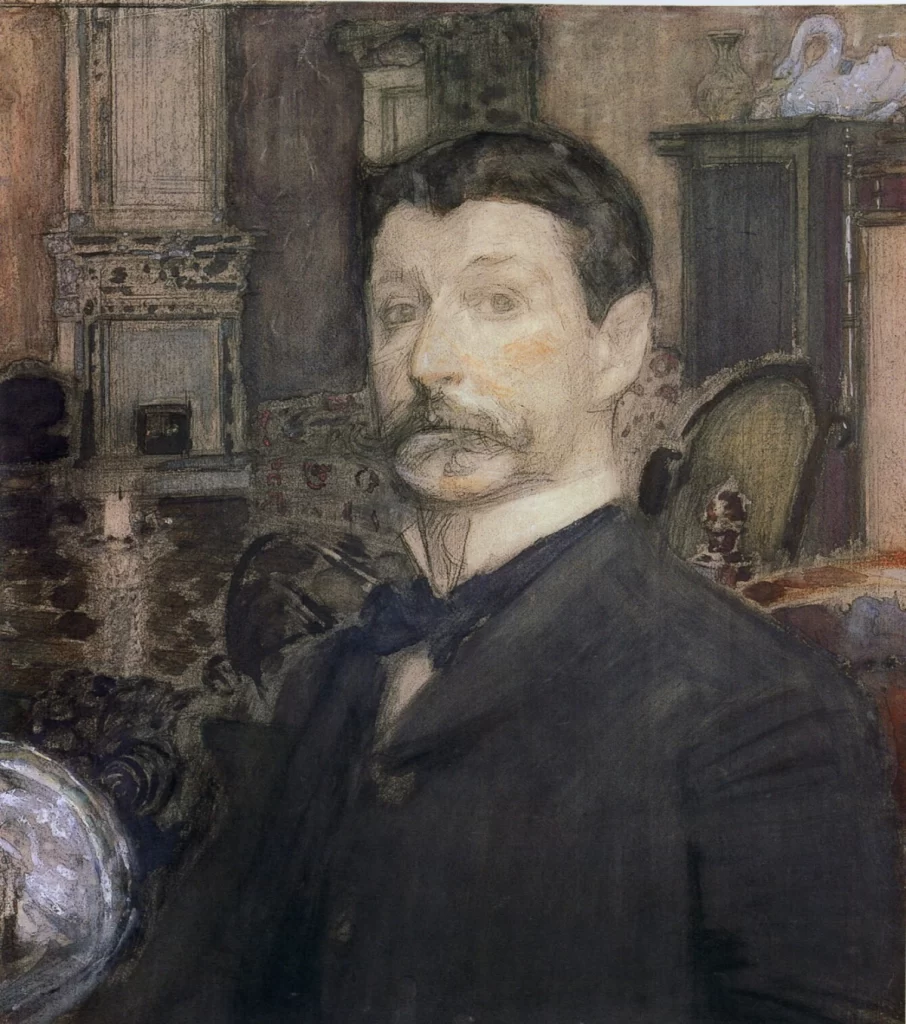
Courtesy – State Russian Museum, Saint-Petersburg, Russia
Mikhail Vrubel’s art was ahead of its time, and he is considered one of Russia’s first modernist artists. The artist was rejecting conventional forms of painting prevalent in his country and was exploring something new in his art, trying to define the cultural and societal changes he was sensing.
The Birth of Mikhail Vrubel’s Art Sensibilities
Initially, Mikhail Aleksandrovich Vrubel had no plans to be a painter– he graduated from St. Petersburg with a law degree. But the young artist soon realised his calling and enrolled himself in Russia’s finest art school, the Academy of Arts in St. Petersburg.
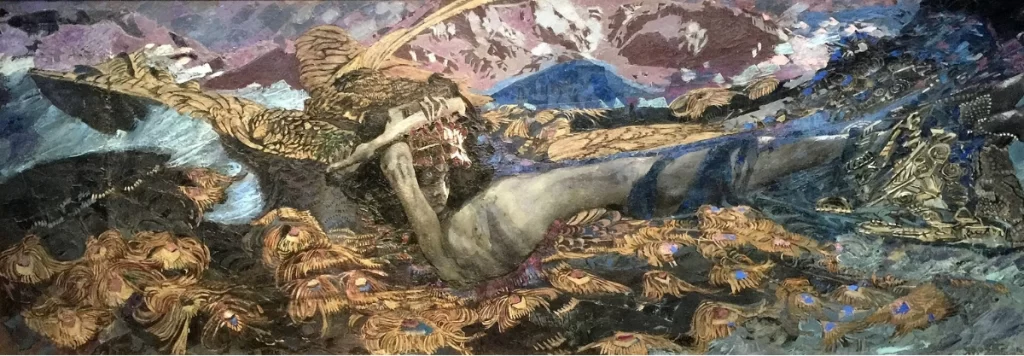
Courtesy – Wikipedia
This is where Mikhail Vrubel’s art found wings. He valued the understanding and perception of the artist’s form and its various nuances. His thorough study of form and explorations into how it could be developed allowed the artist to branch out and utilise other artistic techniques not endorsed by the Academy. He wanted to deconstruct and restructure the form of a painting, take different elements apart and restructure them in a way the painting becomes whole, yet varied. This is what led him to reject the traditional forms and experiment with new techniques that allowed him to project the confounded throughs resting in the shallow crevices of his psyche onto the canvas.
Mikhail Vrubel’s Paintings as an Example of Religion and Spirituality
After finishing at the Academy, Vrubel took on many commissions in Kyiv, where he focused his study on restoration. He was approached by art historian and archaeologist, Adrian Prakhov, who was looking for a promising young artist to help him carry out a large-scale restoration of the 12th century St. Cyril’s Church. Vrubel took on this restoration project and a couple of others, where he restored frescoes at many historical places, including St. Vladimir’s Cathedral.
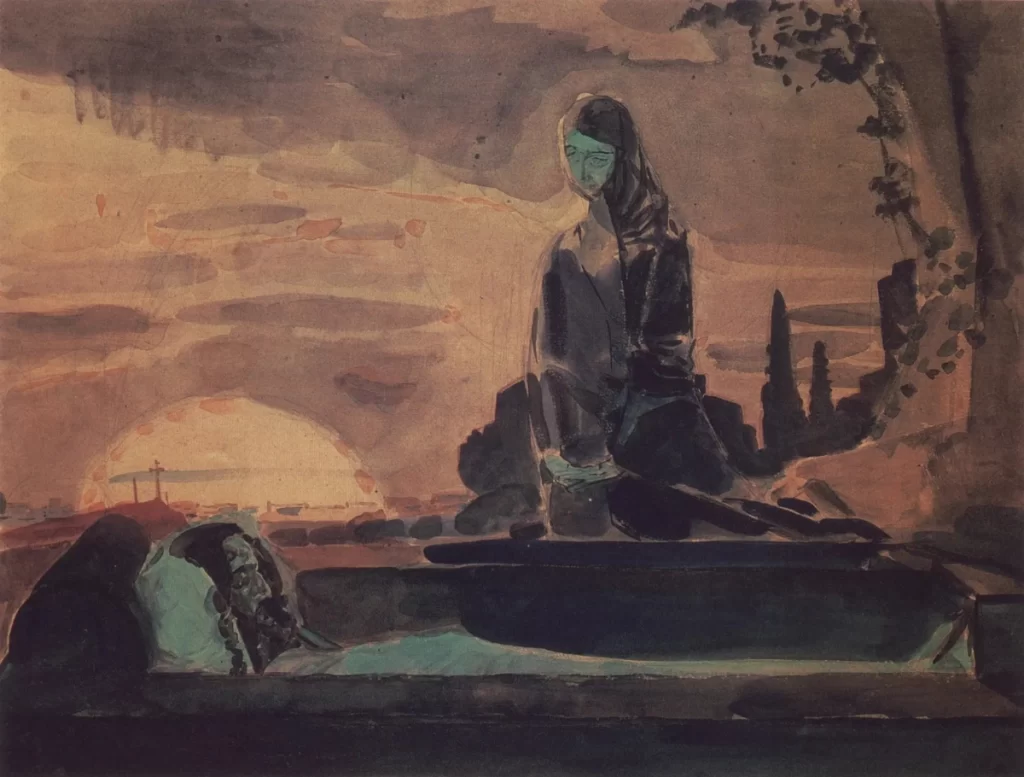
Courtesy – Arthive
Even though Vrubel was restoring Church paintings, he had started to have doubts about religion. Organised religion felt oppressive to him and he had severe loss of faith in Christianity. To Mikhail Vrubel art itself was a substitute for religion, encompassed by his famous phrase, “Art- this is our religion”. He viewed art as a method of attaining spiritual fulfilment, wherein the process of artistic creation itself becomes the medium, so to say, the prayer that allows you to start on the journey.
The time he spent restoring St. Cyril’s Church allowed the artist some introspective time. He battled with his internal philosophies and questioned religion, myths and selfhood, investigating the essence of what it is to create art. Mikhail Vrubel’s art on the frescoes and icons was formative; this essentially kickstarted his introspection into the thematic content and gave him insight into new techniques he could utilise.
The Demon Seated (1890)
One of the most famous Mikhail Vrubel paintings, The Demon Seated (1890) reflects the transition and his deep contemplation. Vrubel had begun experimenting with illustrations for this painting whilst still in Kyiv, but he had only started the painting once he had settled in Moscow. It was inevitable that the artist, stifled by the strictness of restoration where he was limited to icon painting, would eventually leave.
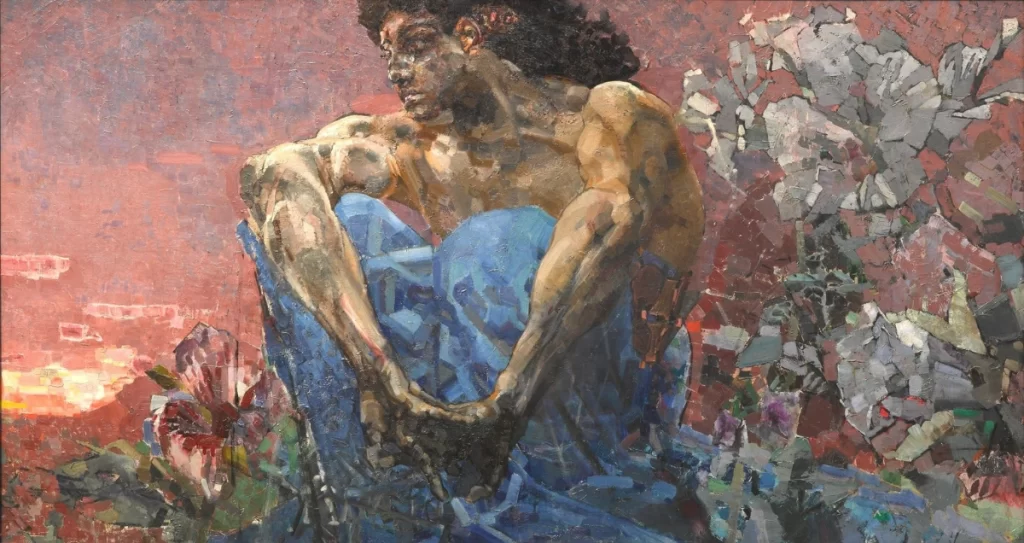
Courtesy – Wikipedia
The Demon Seated mirrors Mikhail Vrubel’s art contemplations and influences; his rejection of Christianity, his disgusted mental state and the techniques he had learnt. Inspired by the Russian Romantic poet Mikhail Yuryevich Lermontov’s 1893 poem titled The Demon, the painting depicts a lonesome demonic figure, crouched down and sitting against an expansive colourful but infinite background, that only slightly alludes to a sunset. Next to the demon, the canvas is decorated with impasto brushstrokes, thick paint layers against itself in a way that recalls the mosaic tesserae of churches. There is depth and volume to this painting, that again emphasises the solitude of the genderless demon who belongs to no place. Vrubel writes to his sister about this creation:
[The Demon is] a spirit which unites in itself the male and female appearances, a spirit which is not so much evil as suffering and wounded, but in all that a powerful spirit…a majestic spirit.
The Swan Princess (1990)
The artist was now fully intent on expressing his unique style as he moved to Moscow. He married the famous opera singer Nadezhda Zabela, the love of his life in 1896, and he started designing costumes for operas in Moscow. This inspired another one of Mikhail Vrubel’s paintings, The Swan Princess (1990). It featured his wife as the main figure.
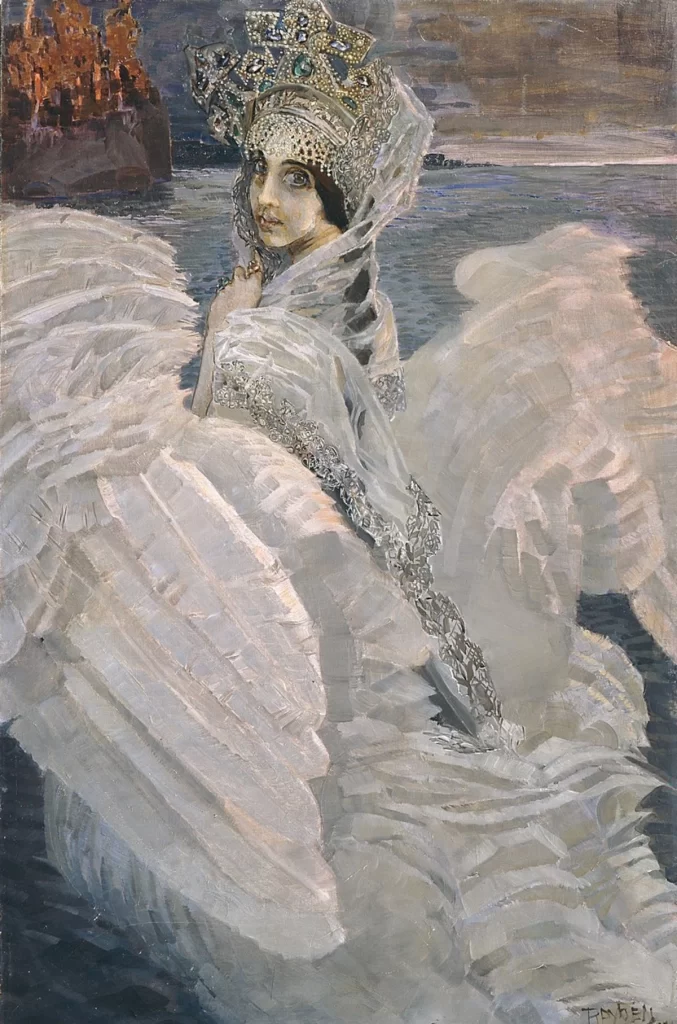
Courtesy – Wikipedia
Moreover than the human, the attention is held by the expansive and abstract white feathers of the Swan Princess’s dress, delicately painted by Vrubel. There is a certain drama to the painting, as the petite figure of the model emerges from the glittery white dress that covers a third of the canvas, looking at the viewer with dazzling eyes and crowned with an intricately drawn headpiece. The Princess is similar to several depictions of the Virgin Mary painted by Vrubel in Kiev; again linking back to the restoration work he had done. The fascination with Russian folktales would haunt Vrubel for the rest of his life.
A Sense of Tragedy in Later Mikail Vrubel’s Paintings
In Moscow, beset by a few personal tragedies like the birth of a son with a physical defect, which the artist saw to be a bad omen, Vrubel’s mental state was not at its best. This was reflected directly in more of Mikhail Vrubel’s paintings in dramatically different ways; whether be it through the chaotic strokes of Demon Downcast (1902) or the investigative pseudo-religious series The Six Winged Seraph (1905). His son’s passing at the age of four further plummeted his mental state and he had to be admitted to the mental clinic.
The artist slowly succumbed to an array of medical ailments, he had lost his vision and had started getting violent seizures in his last year. He did not want to live after losing his ability to paint, which was his only solace, his spiritual comfort in life and after several attempts at sabotaging his health, the artist finally passed away in 1910. Despite his tumultuous career and melancholy-filled life, Mikhail Vrubel’s art is remembered as a pioneer of symbolism in Russia.
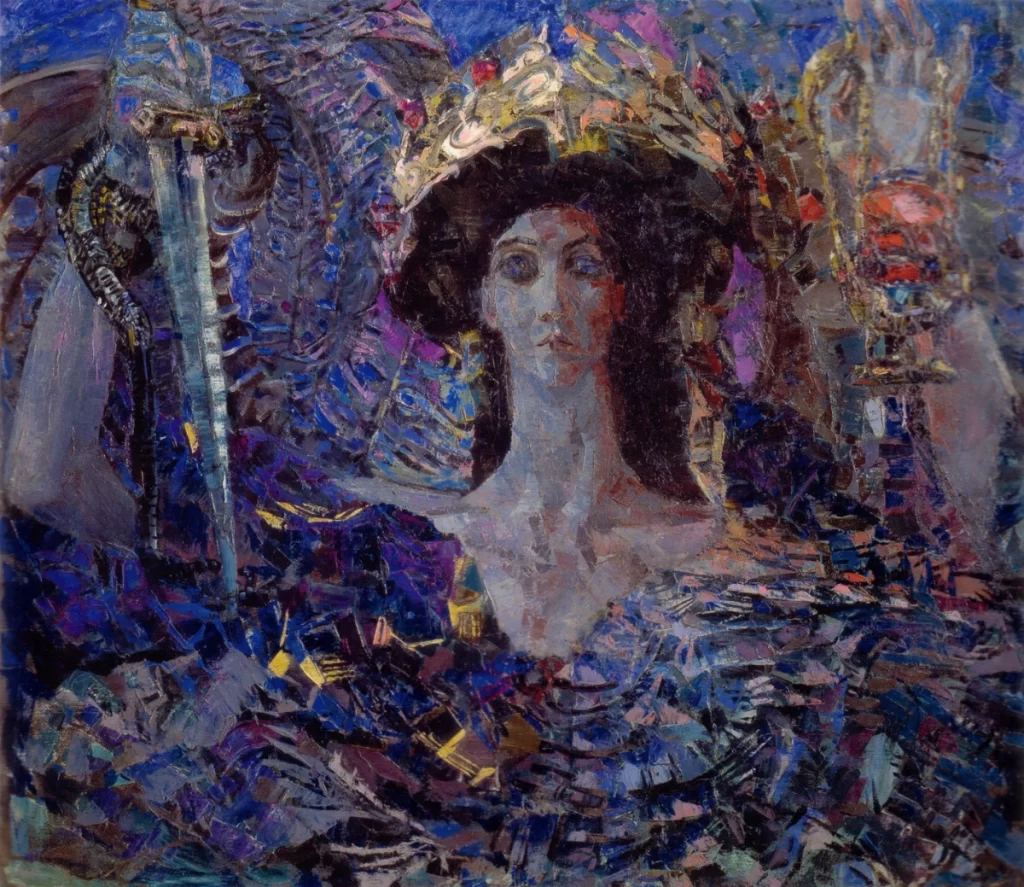
Courtesy – State Russian Museum, Saint-Petersburg, Russia
He was hailed a great master by the Russian avant-garde artists that followed him. The expanse of his legacy is best reflected in the words of Sergei Sudeikin, a Russian avant-garde painter active decades after Vrubel’s passing:
All the principles of Cubism, Constructivism and Surrealism were founded by Vrubel. And despite our respect for Picasso, the real beginning of modern painting was Vrubel.
Image – The Flying Demon (1899). Courtesy – Art History Project





